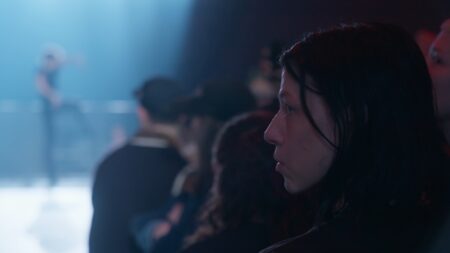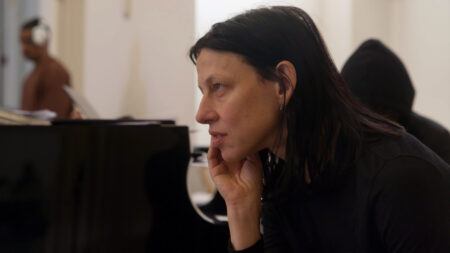When we first started filming with Anne around her performance Doom: House of Hope at the Park Avenue Armory, it really struck me how collaborative the production was. She brought together artists from different disciplines, such as ballet dancers, bone breakers, skateboarders, punk rock bands, and vocalists, and opened up the creative process to incorporate all of their different ideas, skills, and perspectives. She really cultivated the collaborative spirit among the cast, and I hope this film illuminates what it can look like to remove barriers and work across disciplines.
In this film, as in every Art21 film, we tried to highlight the artist’s creative process, but what was especially interesting about this project was that Anne herself was trying to showcase the creative process to the live audience. While the show was a year in the planning and the team had weeks of rehearsal, the piece evolved rather substantially throughout its one and a half week run. Anne was there directing live for each performance, so you see her amongst the audience making decisions.

To document a complex live performance like this, hiring the right crew was super crucial. Jarred Alterman, with whom I’ve worked for over 15 years, was the primary cinematographer. I knew that he would be the right person for this, not only because he’s worked with Art21 for a long time and understands what we’re looking for, but also because he has a lot of experience capturing performances. Usually, when filming a performance, you watch it during rehearsals to understand the different acts and movements, so you can prepare the camera crew as much as possible. For this work, because it was evolving every night, it was hard to block out exact camera positions in advance, the way that you normally would.
Instead, we went in with a list of priorities and overarching strategies. I feel like the movement of the performance demands movement from the cameras to match the energy of the work, so we didn’t use any tripods. We had two hand-held cameras, one of which was on a gimbal that allowed the cinematographer to move fluidly with the performers to capture movement. I wanted the cameras’ movement to mimic the audience’s experience of the work, since there weren’t any seats in the space and the audience was encouraged to move around. The goal of our films is always to convey what it was like to experience the work in person, and so movement became central to the documentation. It was also important for me that we balance getting the shots we wanted and being respectful of the audience, so that we’re not a detriment to their experience. While I was giving notes to our crew along the way, I was also reminding myself that we were making a short film. There are multiple timelines happening simultaneously all throughout the space, and it’s impossible to be comprehensive. It’s really about giving the cinematographers permission and letting them know that they should trust their instincts.

My favorite scene of the film is the ending, which is also the end of the performance. For a durational work like this, you get more invested the longer you watch, and the work builds on you over time. At the end, there was just this moment of release that felt ecstatic. We filmed on the closing night, so you could sense this feeling of accomplishment from the performers as well as Anne. Being able to capture that moment was really rewarding, and narratively, seeing the performers go back out that door onto the street that they’d come into at the beginning of the show was a full-circle moment. It was just an incredible scale of a performance, and getting to see something culminate so dramatically was really beautiful.

In addition to Doom: House of Hope, we also showcased another one of Anne’s exhibitions in the film. The exhibition took place in Bregenz, Austria, and she titled it Wish You Were Gay. Because Anne works in multiple disciplines, like sculpture, painting, and installation, the exhibition was an opportunity to give our viewers a wider view of her practice. Unfortunately, the posters with the title of the exhibition posted around Bregenz were slashed and vandalized. In talking with Anne further, we got to understand how that inspired her to revisit experiences of her younger self coming out, being a young mother, and opening up about her sexuality in public, and how that fed into what became Doom: House of Hope, and her desire to make the statements that she makes in this work.
Doom: House of Hope was created leading up to the presidential election and staged right after Trump was inaugurated. The piece touches on the ideas of bodily autonomy and being able to love who you love publicly without threat or government interference. Now, these ideas are under assault more than before, and so the timing of this work took on more importance and reminded us that nothing should be taken for granted. Seeing things go backwards reinforced the importance of the ideas Anne was highlighting. The role of the artist is to remind us of these issues and find new ways for us to center them.
IMAGES: Production stills from the Extended Play film, “Anne Imhof: DOOM.” © Art21, 2025.


